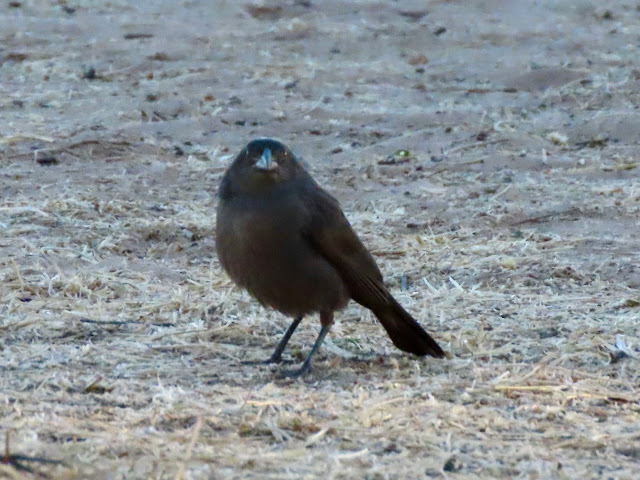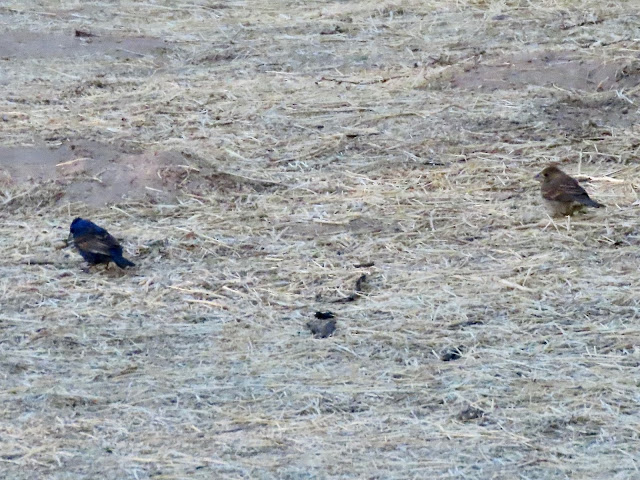Thursday, June 24, 2021
This morning I had planned to drive up to the White Mountains to do some birding. How could this go wrong?
A notification had landed on my computer yesterday announcing CLOSURE of the Apache-Sitgreaves Forest for the immediate future as a fire prevention measure. With 15 forest fires already going strong in the State of Arizona, I could understand the move and sullenly supported it.
But I can't even go birding? . . . I gave that some thought trying to figure out how a birder could accidentally start a wildfire. Unfortunately, I came up with a scenario that gave me pause. Suppose I'm driving a rugged dirt road and the undercarriage of my high-clearance vehicle strikes a rock, creates a spark that catches to some dry grass on the roadway that then finds its way over to an open field and. . . wildfire. And, I've gone on down the road not even aware.
I needed that image to calm my displeasure. I'll stay alert to possible changes if our tinderbox state gets some decent monsoon rains this year instead of a repeat of last year's "nonsoon." Covid ..... local extreme heat conditions with temps reaching 117°F . . . followed by many wildfires..... we're fighting our way back to dramatic more ancient times, it seems.
Up early, I decided to visit my stand-by river spot at Coon Bluff in Mesa. Normally a twenty-minute drive, I managed to stay calm behind a slow-moving truck, but still arrived by 5:17 a.m. with a healthy temperature of 68°. Mine was the first car in the parking lot this weekday morning, so I spent a good twenty minutes right there trying to catch up with the birds behind all the songs I was hearing. I need to fess up that there are few photos. I dropped my camera the other day and it's giving me some very shaky shots that normally wouldn't be so. I'll give it a few more tries to right itself before I take it in for a check-up.
With a list of about twelve species, it was time to walk down the dirt road toward the River beyond the Bluff. Reaching the river, I turned onto that narrow dirt path below the bluff, where the first thing I noticed was NOT A BIRD. It was a happy-go-lucky STRIPED SKUNK prancing toward me as if I was its long-lost friend. No, no, no! Stuck between the bluff and the edge of the cliff above the river, I really had no place to go. The skunk looked way too happy. But it had the solution. . . when it got within about five feet of me, it dipped down holding onto vegetation at the top edge of the cliff. I shot off a few quick photos without expecting to catch anything as I walked forward really really fast.
Maybe it just wanted its picture taken. Having never seen this kind of skunk until I came to live in Arizona, it's the largest in the State and the most common one - often seen as roadkill. Take a look at the tail on this one. And follow the white stripe on its back down to the top of its head where it then becomes a thin line running down its face. That was my last look at it. Never saw it again.
There were plenty of birds but not many in the mood to pose for photos. HOUSE FINCH were busy going hither and yon taking time to perch and sing.
LESSER NIGHTHAWK were numerous but seemed to divvy up the river among themselves with a constant 8-10 always beside me but not necessarily the same birds.
A quick catch of a GREAT BLUE HERON searching for breakfast in a wavy backwater of interesting colors fascinated me.
. At one opening in the thick shrubs/trees along the river, I spotted a young woman standing on her paddleboard taking photos of horses enjoying the cold-water river current...including one, below, just standing still.

Farther along the river, I came upon a whole band of horses crowded along the shoreline, some standing in the shallow sides.
Ordinarily, VERMILLION FLYCATCHERs are not so abundant as they were today. In combination of male and female, I took many photos of each. Fortunately, I have one good one to share.

Hopefully, our hottest days are behind us. (Joke). Whenever the temperature at 4 a.m. is lower than 80°, I'll be heading out to another local birding spot.
Maybe, I'll see you along the way.
View this checklist online at https://ebird.org/checklist/S90691444


































